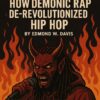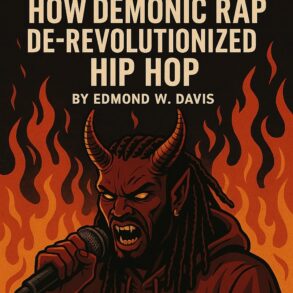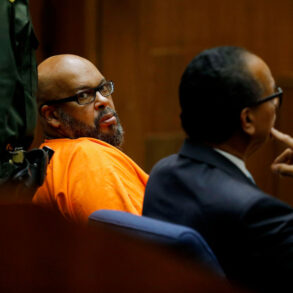For more stories like this one, subscribe to A People’s History of Kansas City on Apple Podcasts or Spotify.
Kansas Citians came together on a bright August day to celebrate their hip-hop heroes at the Gem Theater in the Historic 18th and Vine district. The show was packed with two and a half hours of performances from many of Kansas City’s greatest rap artists.
“I had no idea that it was going to be such a wonderful time and such a family reunion,” said Aaron Yates, better known as Tech N9ne, whose surprise performance brought the crowd to their feet.
The self-proclaimed lyrical warrior The Popper got on the mic, too. And the legendary DJ Fresh put on a masterful set.
“It was spitters,” said Carlos Evans, a native New Yorker who has produced records as Fantom of the Beat for rap heavyweights like Busta Rhymes and 50 Cent. Evans produced the beat for the cypher segment of the show, when young talents like TNTLKP, Roblo DaStar and others took turns exchanging freestyle verses.
“To see these fire-spitting artists over a track that I did? For hip-hop’s 50th? You can’t explain that feeling,” Evans said.

Lawrence Brooks IV
/
KCUR 89.3
From the BET Awards in Los Angeles to a packed Yankee Stadium performance in New York City, America has been celebrating 50 years of hip-hop all year. These high-profile events often center on the coasts, but Kansas City’s scene has its own unique story — and it deserves more credit.
“What people get wrong about KC hip-hop is that it’s nonexistent,” Tech N9ne said. “And it’s so existent. There’s all types of hip-hop in KC.”
An underground phenomenon
Hip-hop traces its roots to a 1973 back-to-school party in the Bronx borough of New York City. Clive Campbell, also known as the legendary DJ Kool Herc, provided the music.
“The creation of hip-hop came from poverty,” said Kansas City music writer Shawn Edwards. “It came from the scraps. It came from a way of putting together elements that already existed to entertain ourselves. It was the way we talked, the way we danced, the way we used spray paint to create artistic masterpieces.”
Hip-hop was late coming to Kansas City. It mostly kicked off in the 1980s, in Kansas City’s predominantly Black neighborhoods east of Troost Avenue. At first, local radio stations like KPRS didn’t play the new and edgy form of music. Instead, it spread through word of mouth and movies that showed hip-hop culture in vivid detail.

Beat Street
/
Orion Pictures
“That’s my first experience of hip-hop, watching ‘Beat Street,’” said Walter Edwin Jr., better known as The Popper. “Hip-hop was a way of life.”
The music also spread through mixtapes created by the godfather of Kansas City hip-hop, Gary Edwin, aka DJ Fresh.
“We’ve been buying DJ Fresh tapes since we were young, young teens,” Tech N9ne said. “DJ Fresh had it locked with mellow music, with hip-hop, way back Wednesday slow music, whatever you needed.”
Before long, hip-hop became the soundtrack to parties at Kansas City dance halls, skating rinks and local high schools. Lincoln High School threw hip-hop parties in the gym every Friday and Saturday night, turning it into the epicenter of a growing movement.
Those who remember the early years of Kansas City hip-hop agree they were idyllic and pure.
“Hip-hop was a thing where you had to go out to hear it,” Edwards said. “There was no violence, no fights, no yelling, no fussing — just straight up hip-hop.”
In some cases, if an altercation did break out, the event was shut down immediately. The practice created a safe space for youths to express themselves. The parties cultivated a prominent local dance scene, which included groups like the Imperial Preps, who went on to dance with MC Hammer.
[embedded content]
“People began identifying themselves with the way they move,” Edwards said.
The ‘golden age’ of Kansas City hip-hop
Early Kansas City rappers honed their skills at competitive battles in Swope Park and elsewhere. The Popper said the contests were organic, and usually involved smoking a “whole bunch of weed, and then we’re just going to go in a circle and just play a beat and freestyle.”
“If anybody wanted to call somebody out, they’d stand on top of the table and then battle the other person,” he said.
As a teenager, Marcyl Goode was immediately attracted to hip-hop. Fortunately for the self-described nerd, his mom was friends with local promoter “Captain Vonzell” Bryant, who mentored Goode and hooked him up with equipment like turntables, mixers, amps and speakers.
“(Vonzell) was real smart,” Goode said. “He could see that the music was changing. So he did a doggone good job of keeping youth around him.”
Eventually, Goode took on the moniker DJ Kut-Fast. His 1989 song “Butt of the Kut” is often credited as one of the first rap songs professionally produced in Kansas City, Edwards wrote for The Pitch.
“I’d say the most fruitful period for KC hip-hop was 1990 to 1995,” Edwards said. “Everybody was young, they were hungry, they were talented and they were dope.”

Major Factor Records
Producers like Sean Raspberry, better known as DJ Icy Rock, and Don Juan got their start around then, and went on to create melodies and beats for some of the city’s most famous rappers. Don Juan also produced classic songs for Oakland artists like E-40 and Mac Dre.
Rappers like Black Walt, Skatterman, Snug Brim, the 57th Street Rogue Dog Villians, and Kutt Calhoun were also making waves in Kansas City during the golden era.
“I got to meet all these early rappers, like Jay Lee and DJ Cut Fast and Tony Roma and all these people,” said Tech N9ne about his time living with DJ Icy Rock. “I was around everybody.”
In 1999, Tech N9ne founded the independent record label Strange Music with business partner Travis O’Guinn. Since then, the pair have built Kansas City’s most successful hip-hop label.

Strange Music
“What he’s been able to accomplish as an independent artist is just beyond belief,” Edwards said. “There should be whole classes (on his success) taught at colleges and universities.”
Tech N9ne’s music has also been featured in film, TV and video games like Madden NFL 06. He’s toured around the world and was one of the highest paid rappers in 2015, according to Forbes magazine.
For women looking to break through in the ‘90s, success was harder to find. The most prominent female rapper from Kansas City at the time was Solé. She began rapping at age 6, and was originally part of an all-female group called Divine before signing to a major label as a solo artist. But in 1999, she left the industry.
“She said when she looked back at it all, she just did not like how they were trying to oversexualize everything she did,” Edwards said. “That just wasn’t her.”
[embedded content]
Solé has re-entered the game, though, inspired by motherhood and her wellness practices.
“I tend to navigate towards whatever the spirit pulls me to authentically,” she told the hip-hop website 247HH in 2018.
Crack, violence and the creation of gangster rap
In September 1989, President George H.W. Bush called crack cocaine the nation’s “gravest domestic threat.”
“Particularly here in Kansas City, the crack epidemic was horrendous,” Edwards said. “Kansas City became a distribution point because of its location in the United States of America.”
Drugs, and the money that came with them, ushered gang culture and violence into Kansas City from the West Coast.

Tech N9ne
/
Tech N9ne
“With that culture, they introduced a brand new style and a brand new sound of hip-hop,” Edwards said. “The lyrics became a little more violent, a little more realistic, a little bit more misogynistic.”
The person credited with making gangster rap a Kansas City staple is Richard Johnson, aka Rich the Factor.
“Rich is the embodiment of gangster s— in Kansas City — they see themselves in Rich,” said Tech N9ne, who performed with gangster rap acts in the ‘90s like the 57th Street Rogue Dog Villians.
While politicians and law enforcement used the war on drugs to clamp down, hip-hop emerged as the countercultural resistance to police brutality, racism and harsh federal anti-drug policies that have imprisoned millions of Black Americans.
Still, the influence of seeing drug dealers’ lives shown in music videos and popular culture attracted many young people struggling to pay the bills.
The intermingling of rap, gang, and drug culture persisted through the ‘90s, creating Kansas City’s unique sound and some of its most iconic songs.
The Kansas City-Bay Area connection
In the early 2000s, Kansas City’s hip-hop sound was closely aligned with the scene in Oakland, California. On many local radio stations, Rich the Factor was in heavy rotation with Bay Area rappers like Messy Marv and San Quinn.
Though the exposure gave local rappers opportunities to expand to larger markets, Oakland’s heavy presence in Kansas City sometimes overshadowed homegrown talent, said producer Don Juan.
“Sometimes they would praise the Bay Area rappers more than they praise their own,” he said.
On Nov. 1, 2004, a rift formed when popular Oakland rapper Andre “Mac Dre” Hicks was shot to death in Kansas City. San Francisco news website SFGATE dubbed it the “West-Midwest rap war.”
Real Life Records
After a performance at the National Guard Armory in Kansas City, Kansas, unknown assailants fired an AK-47 into the van Hicks was traveling in on U.S. Highway 71. The 34-year-old was pronounced dead at the scene.
While rappers from the Oakland area assumed someone from Kansas City was responsible for Hicks’ death, no one was ever convicted and the case remains unsolved.
Less than a year later, up-and-coming KC rapper Anthony “Fat Tone” Watkins and another Kansas City rapper, Jermaine “Cowboy” Akins, were shot and killed in Las Vegas. Police investigators there said it was retaliation for the murder of Mac Dre. In Kansas City, police eventually claimed Fat Tone had no involvement in Mac Dre’s killing.
For some, the incident shattered Kansas City’s reputation in hip-hop.
“I think it still shines a negative light on the city. I think people don’t want to come here,” said Don Juan. “It messed up a lot of stuff for Kansas City, as far as going into the hip-hop community outside.”
The tragedy of that moment still confounds Tech N9ne.
“It doesn’t make no sense that Mac Dre died here, man, because (Kansas City) loved Mac Dre,” he said. “That’s how you know that it was street s— that happened.”
“We are all intertwined, man, with the Bay and KC for forever,” Tech N9ne said.
Kansas City hip-hop today
Women have always been a part of hip-hop. But 50 years after its debut, they’re more represented than ever.

Lawrence Brooks IV
/
KCUR 89.3
“I feel like women (have) been suppressed enough. And so our voices are bigger and louder,” Shay Lyriq told KCUR’s Up To Date in August.
The Kansas City native has had a passion for music since she was a teenager listening to her dad’s rap and R&B albums, Lyriq said, and she used to fantasize about being a part of the Kansas City scene. Now, it’s happening.
Tech N9ne, now 52, showed no signs of slowing down in 2023, when he released his 23rd album, “BLISS,” and went on tour. His success in the industry has paved the way locally and nationally for a new generation of Kansas City rappers.
That includes SleazyWorld Go, whose popularity has surged since 2021.
“SleazyWorld Go is killing it. He’s about to go platinum off his second single,” said Edwards. “DWalk is killing it.”
Kemet Coleman, who co-owns Kansas City’s first Black-owned brewery, 2Gunn Kevi and Gametight Mike also help carry on Kansas City’s rap culture.
In production, musicians like Lil’ Ronnie Jackson, Brian Kennedy, Dominique Sanders, Justus West, Denzel Conductor Williams and Anthony J. White all shine.
The Kansas City cohort has produced tracks and won awards working with high-profile artists like Snoop Dogg, Kendrick Lamar, Cardi B, Conway the Machine, Ludacris, Drake and Future.

Mike Savage
/
Shawn Edwards
Still other Kansas City musicians are more than happy to remain hometown hip-hip heroes.
“It’s not like everybody’s objective is like, ‘I want to be a famous rap star,’” said The Popper. “Some people, like, shoot — they just want to hold it down.”
Today, The Popper supplements his artistic pursuits, and celebrates his hometown pride, with two retail stores called IMKC Clothing Company, in the 18th and Vine district and at Ward Parkway Mall.
“That started with a song called ‘I’m KC,’” he said. “I turned the song into a movement.”
That movement includes songs and fashion that celebrate Black history in Kansas City.
[embedded content]
Socially conscious rap like that reinforces the roots of hip-hop, and demonstrates its long history of resistance to oppression.
“Whether it’s like the push against sexism, the push against ageism, economic disparity, police brutality — it’s always been in the music,” Edwards said.
This episode of A People’s History of Kansas City was reported by Lawrence Brooks IV, produced by Mackenzie Martin, edited by Luke X. Martin, and mixed by Suzanne Hogan and Anna Schmidt. For more hits from Kansas City’s hip-hop history, check out Shawn Edwards’ playlist on Spotify.
This post was originally published on this site be sure to check out more of their content.






